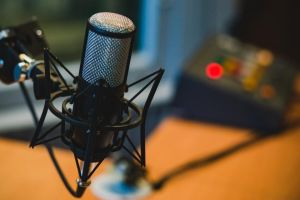Podcast Tips for Your Business
Updated 31 May 2021 (Published 23 October 2017) by Miles in Digital Marketing
On this episode of The Bam Creative Show, we shared some of our tips for creating a podcast for your business.

Episode 14
Show notes
On this episode, we talked about how to get into podcasting as well as sharing our podcasting tips.
Episode highlights:
- How to decide whether or not podcasting is for you
- How to plan podcast topics and episodes
- Hardware and software for recording and publishing
- How to tell your brand story with your podcast
You can listen to or watch the episode or you can check out the extended full post below.
Got questions?
We want to hear from you! If you have any questions about this episode, tweet us @bamcreative.
Podcasting tips for your business
We tried our hand at writing, but it just wasn’t happening for us.
We needed to switch things up, and choose something that could help us scale.
So, we chose podcasting.
We learned some things along the way, and so on this episode of the Bam Creative Show, we shared some of our tips for podcasting, including:
- How to plan episodes and content
- Sourcing equipment
- Figuring out whether podcasting suits your business
- Other types of content that can complement a podcast
Why do people listen to podcasts?
The ABC recently held their annual Podcast Conference: OzPod2017, and shared some interesting survey results, listing the reasons why people like listening to podcasts.
Understanding why people like listening to podcasts can help you decide on the theme and content for yours.
- To pick content that I am interested in (73%)
- To inform me (67%)
- To listen to audio when I want/where I want (61%)
- To entertain me (57%)
- Catch up on broadcast radio (53%)
- As I can multitask (49%)
- Alternative to radio (37%)
- Keep me company (26%)
- Other (13%)
Does podcasting work for your business?
When it comes to deciding on podcasting as a main pillar of content (see episode 6 show notes for more info on this) you have to do your research, because you may find that your target audience prefers to consume written or visual content, over audio.
Here are some ways to help you decide on your preferred type of content:
- Review your current content marketing strategy to take stock of what is working and what isn’t
- Run a branding workshop. This will help you to define your message and your target audience, figure out what you want to say and how to say it with the right pillar. Check out episode 4 for more details on running a branding workshop
- Do some research into your target market and discover how they consume content
- Do what you’re comfortable with because if you don’t enjoy it, you’ll struggle to create content of value and it will be obvious to your audience
If you have a very visual aspect to your business, Instagram and YouTube could go hand in hand to increase your brand awareness. People identify with their eyes first, which is why we introduced a visual element to our podcast and it has proven to be more popular than our audio content.
If you’re thinking about which pillar of content to go all in on first before expanding, then definitely go with your strong point.
Get your equipment sorted
Podcasting doesn’t have to be difficult.
With Anchor rising in prominence, allowing you to record podcasts with your phone and publish episodes to iTunes, it’s never been easier.
A lot of people tend to start creating content by writing, because it’s so much easier than either audio or video content. If you don’t have a website, there are many sites that you simply start publishing to right now, like Medium or Wordpress.com.
It’s still early days for our podcasting project, so we’re keeping our costs low and using equipment we already have on hand.
For our podcasts, we use:
- Rode NT USB microphone. It’s an inexpensive but good quality mic that plugs straight into your computer through USB. You don’t need a mixer or soundcard
- For editing, we use GarageBand and iLogic. We’ve also been known to use Audacity which is free
- We host and publish our podcast with Libsyn, as it’s easy to use and also quite affordable. It publishes directly to iTunes and other feeds, so we don’t have to do a thing.
In regards to editing, we don’t tend to edit much except for the start and beginning of the podcast. We like to keep things as authentic as possible. Editing is quite simple, and there are plenty of tutorials on YouTube about sound editing which are handy if you’re new to it all.
For all of our video content, we use:
- A Samsung Galaxy Note 5, which records in Full HD
- Adobe Premiere to edit our full video and video clips
For video segments under half an hour, a phone editor is sometimes use. We like:
- Adobe Clip (cloud licence required)
- iMovie
Our video editing is quite minimal, too. We simply remove the beginning and end so it doesn’t require intense editing. Again, there are a lot of tutorials on YouTube to help get you started.
People enjoy a good story
The nature of our podcast content has evolved over time.
Initially, it began as the complete and authoritative guide on all things digital marketing.
The advantage of this being that there is a wealth of content within each episode, which makes scaling it a whole lot easier.
The problem is that a lot of people listen to podcasts at home, in the car, at the gym and sitting next to some weird guy on the bus on the way to work - it means that it becomes impossible for people to be engaged in the story because there is no story at all.
ABC did make the point to note that people like listening to podcasts to be informed, but it’s almost parity with being entertained.
It’s because, no matter the subject of the content or what we happen to be doing at the time: people enjoy a good story.
So, in between the 7th and 8th episode, we changed our tune and focussed on the story.
How do we inform and entertain?
How do we introduce storytelling into digital marketing?
And what will this achieve?
What it really comes down to is that the three of us are a reflection of Bam Creative - we’re passionate, and a little bit geeky about the web. It means that we’ve got experience and stories about Web 2.0, before Google existed, and how Kim Kardashian followed Richard on Twitter for 5 minutes. It was a mistake.
But these stories mean that you get to know us, whilst learning a thing or two. The aim is to build rapport with you, even if you’ve never met us.
This does, however, mean that this idea or direction isn’t going to take with everyone. Some people might like our earlier episodes, or some people might like the more light-hearted approach.
But after looking at the data - so far, so good.
Planning topics
Planning for your podcast can vary, depending on your industry.
Generally, our planning is loose to accommodate for the fast pace of the industry we’re in.
Our content is influenced by our industry, where things change constantly. It’s great, because it means we can talk about things that have happened within the past week or so, like the Twitter episode. The increase to 280 characters happened the morning of our podcast, and so we quickly changed topics to suit the event.
Sometimes, we’ll plan topics weeks in advance. We’re also mindful that not everyone is strong in the topic we’re discussing, so our planning is influenced by our strengths as individuals and as a whole.
Some weeks, an episode may come from a more organic place without any planning at all, which involves the opinions and storytelling of all three of us.
Avoiding awkward silences and keeping the flow going
Podcasting relies only on speech, and so there is an intense focus on the way we communicate with each other.
Listening to other podcasts, no matter the subject, has helped us realise how we communicate with each other during the recording of an episode.
It’s made us more conscious of our roles: the interviewer, the subject, the voice of the audience - we’re conscious of all of these aspects which helps us keep the conversation going.
More importantly, we’re focusing on keeping the episode as informative as it is entertaining, to keep people engaged and give them value.
With more episodes under our belt, we have developed a more natural flow with our episodes focusing on edutainment in a conversational tone, rather than a complete, authoritative guide on a subject.
Communicating with your listeners
Though prevalent on iTunes, podcasts aren’t owned by any single platform and a lot of the content is timeless.
It leaves the doors open for listeners to comment on your podcast any time they listen to it, and they’re not confined to a single way to communicate with you.
We love Twitter for this, because its linear timeline is perfectly suited for your audience to respond to an episode.
We’ve also found that creating an email address just for the podcast, means that people can send thoughts and questions that exceed the Twitter character limit.
We’ve also upped the ante with our email marketing campaign, sharing targeted content based on podcast episodes which keeps our listeners engaged.
Whatever you do, your listeners keeps you going so make sure you leave the communication channels open.


